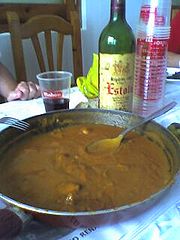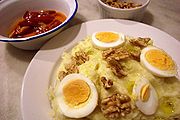
Castilian-Manchego cuisine
Encyclopedia



Castile-La Mancha
Castile-La Mancha is an autonomous community of Spain. Castile-La Mancha is bordered by Castile and León, Madrid, Aragon, Valencia, Murcia, Andalusia, and Extremadura. It is one of the most sparsely populated of Spain's autonomous communities...
region of Spain
Spain
Spain , officially the Kingdom of Spain languages]] under the European Charter for Regional or Minority Languages. In each of these, Spain's official name is as follows:;;;;;;), is a country and member state of the European Union located in southwestern Europe on the Iberian Peninsula...
. These include pisto
Pisto
Pisto is the name of a Spanish dish typical from the Region of Murcia. It is made of tomatoes, onions, eggplant or courgettes, green and red peppers and olive oil. It is similar to ratatouille and is usually served warm to accompany a dish or with a fried egg and bread...
(a vegetable stew with tomato sauce), gazpacho manchego, the famous queso manchego (a type of cheese
Cheese
Cheese is a generic term for a diverse group of milk-based food products. Cheese is produced throughout the world in wide-ranging flavors, textures, and forms....
), the white wine of La Mancha
La Mancha
La Mancha is a natural and historical region or greater comarca located on an arid, fertile, elevated plateau of central Spain, south of Madrid, stretching between the Montes de Toledo and the western spurs of the Serrania de Cuenca. It is bounded on the south by the Sierra Morena and on the north...
, and the red wine from Valdepeñas
Valdepeñas
Valdepeñas is a municipality in the province of Ciudad Real, in the autonomous community of Castile-La Mancha, Spain. It is also the seat of the judicial district that covers the localities of Moral de Calatrava, Santa Cruz de Mudela, Viso del Marqués, Torrenueva, Castellar de Santiago and...
.
The dishes and specialties of the region are generally sober and sensible, reflecting a modest, rural origin. They contain a limited number of ingredients. Ingredients tend to be those most easily accessible by the locals. Dishes tend to be high in calories, ideal for the diets of laborers, farmers, and shepherds. The cuisine of this area was popularized by Cervantes
Cervantes
-People:*Alfonso J. Cervantes , mayor of St. Louis, Missouri*Francisco Cervantes de Salazar, 16th-century man of letters*Ignacio Cervantes, Cuban composer*Jorge Cervantes, a world-renowned expert on indoor, outdoor, and greenhouse cannabis cultivation...
in his Don Quixote de la Mancha, where a number of traditional dishes are mentioned.
Staples
Local traditional staples in La Mancha were gachasGachas
Gachas is an ancestral basic dish from central and southern Spain. Its main ingredients are flour, water, olive oil, garlic and salt.- Origin :Gachas are based on a very ancient Iberian flour-based staple food preparation....
de almorta, made with grass pea (Lathirus sativus) flour, and tortas de gazpacho, a flat bread that is the base for the "gazpachos", an elaborate dish appearing in El Quixote under the name of "galianos". Nowadays bread
Bread
Bread is a staple food prepared by cooking a dough of flour and water and often additional ingredients. Doughs are usually baked, but in some cuisines breads are steamed , fried , or baked on an unoiled frying pan . It may be leavened or unleavened...
is much more widespread.
Fruits and Vegetables
There are not many purely vegetarian dishes in the region. One of the local vegetables are Silene vulgarisSilene vulgaris
Silene vulgaris, Silene cucubalus or Bladder Campion is a plant species of the genus Silene of the Pink Family . It is native to Europe, where in some parts it is eaten, but is widespread in North America where it is considered a weed..-Gastronomy:In Spain, the young shoots and the leaves are used...
leaves, known as (collejas), quite uncommon as a vegetable elsewhere. Some traditional vegetable-based dishes are pisto manchego
Pisto
Pisto is the name of a Spanish dish typical from the Region of Murcia. It is made of tomatoes, onions, eggplant or courgettes, green and red peppers and olive oil. It is similar to ratatouille and is usually served warm to accompany a dish or with a fried egg and bread...
, pipirrana (a salad of onion, tomato, and cucumber), asadillo de la Mancha (roasted red peppers), and gazpacho viudo. The berenjenas de Almagro are a variety of small aubergines that are grown in Almagro, Ciudad Real
Almagro, Ciudad Real
Almagro is a city situated in Ciudad Real province, in the autonomous community of Castile-La Mancha, Spain.A tourist destination, Almagro is an important Historical-Artistic Zone ....
. These are seasoned and pickle
Pickling
Pickling, also known as brining or corning is the process of preserving food by anaerobic fermentation in brine to produce lactic acid, or marinating and storing it in an acid solution, usually vinegar . The resulting food is called a pickle. This procedure gives the food a salty or sour taste...
d according to a traditional recipe and usually eaten as a snack or side-dish.
A common ingredient found in almost all local dishes is garlic
Garlic
Allium sativum, commonly known as garlic, is a species in the onion genus, Allium. Its close relatives include the onion, shallot, leek, chive, and rakkyo. Dating back over 6,000 years, garlic is native to central Asia, and has long been a staple in the Mediterranean region, as well as a frequent...
. A local sweet pepper, the ñora
Nora
Nora or Norah may refer to:*Nora , an English and Irish feminine personal name* Nóra , a Hungarian feminine personal name-People:*Nora Aunor, a multi-awarded Filipino actress-singer-producer*Norah Baring, a British movie actress...
, is also a main ingredient of many dishes.
Meat and Fish
There are many local meat dishes, which consist primarily of sheep, goatGoat
The domestic goat is a subspecies of goat domesticated from the wild goat of southwest Asia and Eastern Europe. The goat is a member of the Bovidae family and is closely related to the sheep as both are in the goat-antelope subfamily Caprinae. There are over three hundred distinct breeds of...
, and, to a lesser degree, beef
Beef
Beef is the culinary name for meat from bovines, especially domestic cattle. Beef can be harvested from cows, bulls, heifers or steers. It is one of the principal meats used in the cuisine of the Middle East , Australia, Argentina, Brazil, Europe and the United States, and is also important in...
. The most important dishes are carcamusas (typical of Toledo
Toledo, Spain
Toledo's Alcázar became renowned in the 19th and 20th centuries as a military academy. At the outbreak of the Spanish Civil War in 1936 its garrison was famously besieged by Republican forces.-Economy:...
), chanfarina, roast lamb, cuchifrito, migas
Migas
Migas is the name used for a dish in Spanish and Portuguese cuisine and a significantly different dish in Tex-Mex cuisine.-Spanish migas:...
, gallina en pepitoria (chicken a la pepitoria), salpicón
Salpicon
Salpicon is a term in French cuisine applied to a preparation consisting of one or more ingredients, diced or minced, and bound with a sauce. The resulting mixture is used to stuff tartlets, canapés, croquettes, rissoles, timbales, vol-au-vents, croustades, eggs, roulades, etc.In Mexican cuisine,...
, paturrillo, and zarajos. In areas where there is a lot of hunting, a number of game based dishes are also popular, such as conejo al ajillo (rabbit with garlic), liebre a la cazadora (hare hunter-style), and caldereta manchega.
The traditional fish of the area is bacalao
Dried and salted cod
Dried and salted cod, often called salt cod or clipfish , is cod which has been preserved by drying after salting. Cod which has been dried without the addition of salt is called stockfish....
(salt cod), which can be found in a limited number of dishes.
Cheeses
Queso manchego, or "cheese from La Mancha", is the best-known cheese from the area. Made from the milk of local sheep (Ovis Aries Ligeriensis) found in the pastures year-round. The cheese is hard, with a strong taste, mild bite, and greasy texture. There are many individual types of queso manchego depending on curing time and tradition (some are submerged in olive oilOlive oil
Olive oil is an oil obtained from the olive , a traditional tree crop of the Mediterranean Basin. It is commonly used in cooking, cosmetics, pharmaceuticals, and soaps and as a fuel for traditional oil lamps...
while curing).
Wines
Wine production is very important to the region, which has many protected designations of originProtected designation of origin
Protected Geographical Status is a legal framework defined in European Union law to protect the names of regional foods. Protected Designation of Origin , Protected Geographical Indication and Traditional Speciality Guaranteed are distinct regimes of geographical indications within the framework...
for the area. The major PDO is D.O. La Mancha
La Mancha (DO)
La Mancha is a Spanish Denominación de Origen for wines, with over 190,000 ha planted to vines, and is the largest continuous vine-growing area in the world. It is located in the autonomous region of Castile-La Mancha in central Spain and includes 182 municipalities: 12 in the province of...
, but others include: D.O. Valdepeñas
Valdepeñas (DO)
Valdepeñas is a Spanish Denominación de Origen for wines located in the province of Ciudad Real in the south of Castile-La Mancha...
in Ciudad Real
Ciudad Real (province)
The province of Ciudad Real is a province of South-central Spain, in the southwestern part of the autonomous community of Castile-La Mancha. It is bordered by the provinces of Cuenca, Albacete, Jaén, Córdoba, Badajoz, and Toledo. Its extent is effectively that of the old province of La Mancha...
; D.O. Méntrida
Méntrida
Méntrida is a Spanish Denominación de Origen for wines covering many municipalities in the northeast corner of the province of Toledo and which is divided into three distinct areas: Talavera, Torrijos, and Sagra-Toledo, with over 26,000 ha under vines, the majority being in...
in Toledo
Toledo (province)
Toledo is a province of central Spain, in the western part of the autonomous community of Castile-La Mancha. It is bordered by the provinces of Madrid, Cuenca, Ciudad Real, Badajoz, Cáceres, and Ávila....
; D.O. Jumilla
Jumilla (DO)
Jumilla is a Spanish Denominación de Origen for wines that extends over the north of the region of Murcia, including the municipality of Jumilla —from which it takes its name— and the contiguous southeast of the Albacete province in the Castile-La Mancha region.There are currently 32,000...
and D.O. Manchuela
Manchuela
Manchuela or La Manchuela is a comarca located in Castile-La Mancha, Spain.-Historical comarca:The historical Manchuela comarca included the municipalities of Tarazona de la Mancha and Villalgordo del Júcar, as well as the Requena-Utiel comarca which had been part of the Cuenca Province until 1851...
in Albacete
Albacete (province)
Albacete is a province of central Spain, in the southern part of the autonomous community of Castile-La Mancha. It is bordered by the provinces of Granada, Murcia, Alicante, Valencia, Cuenca, Ciudad Real and Jaén....
; D.O. Mondéjar in Guadalajara
Guadalajara (province)
Guadalajara is a province of central/north-central Spain, in the northern part of the autonomous community of Castile-La Mancha. It is bordered by the provinces of Cuenca, Madrid, Segovia, Soria, Zaragoza, and Teruel...
, etc. In addition there are numerous home-made wines, such as the sacramental wine
Sacramental wine
Sacramental wine, Communion wine or altar wine is wine obtained from grapes and intended for use in celebration of the Eucharist...
s known as "pitarras."

